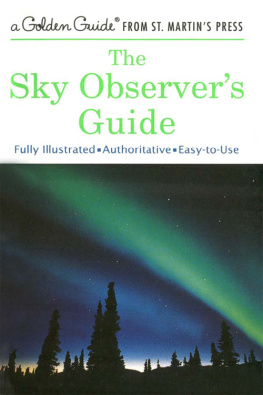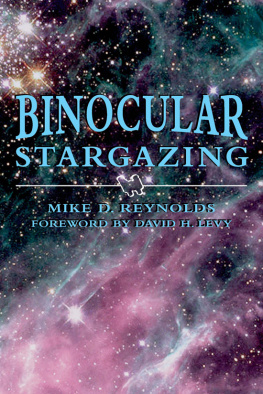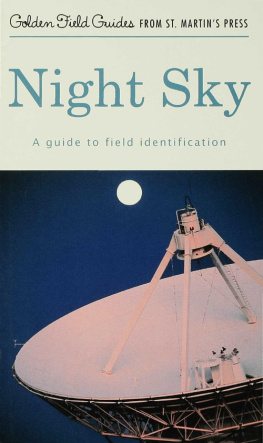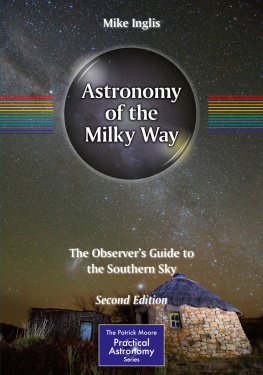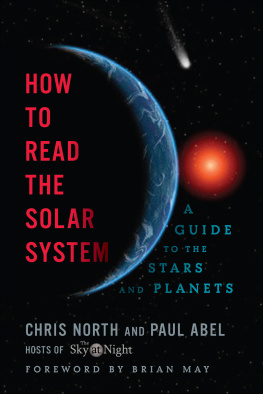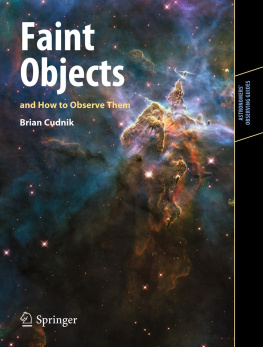Complete your collection of Golden Guides and Golden Field Guides from St. Martins Press!
Golden Guides from St. Martins Press
Bats of the World Bird Life Birds Butterflies and Moths Dinosaurs Endangered Animals Exploring Space Fishes Fishing Fossils Geology Insects Mammals North American Indian Arts Planets Poisonous Animals Pond Life Reptiles and Amphibians Rocks, Gems and Minerals Seashells of the World Seashore Life The Sky Observers Guide Spiders and Their Kin Stars Trees Tropical Fish Tropical Rainforests Weather Weeds Whales, Dolphins and Other Marine Mammals Wildflowers
Golden Field Guides from St. Martins Press
Birds of North America
Eastern Birds
Reptiles of North America
Rocks and Minerals
Seashells of North America
Night Sky
Trees of North America
Wildflowers of North America
THE SKY OBSERVERS GUIDE
A HANDBOOK FOR
AMATEUR ASTRONOMERS
a Golden Guide from St. Martins Press
by
R. NEWTON MAYALL, MARGARET MAYALL
and JEROME WYCKOFF
Paintings and Diagrams by
JOHN POLGREEN

The author and publisher have provided this e-book to you for your personal use only. You may not make this e-book publicly available in any way. Copyright infringement is against the law. If you believe the copy of this e-book you are reading infringes on the authors copyright, please notify the publisher at: us.macmillanusa.com/piracy.
THE SKY OBSERVERS GUIDE. Copyright 2002 by St. Martins Press. All rights reserved. St. Martins Press, 175 Fifth Avenue, New York, N.Y. 10010.
www.stmartins.com
A Golden Guide is a registered trademark of Golden Books Publishing Company, Inc., used under license.
ISBN 1-58238-155-0
eISBN 9781466864870


Becoming a Sky Observer
All of us, from childhood, have gazed at the sky in wonder. Sun and Moon, the wandering planets, the fiery trails of comets and meteorsthese are things to marvel at. Man will never tire of looking up into the tremendous, sparkling bowl of space.
Sky watching was undoubtedly a pastime of prehistoric man. The ancient Egyptians and Babylonians, several thousand years ago, observed the heavens carefully enough to devise quite accurate calendars. Observations by Copernicus, Galileo, and others in the sixteenth and seventeenth centuries were among the first great steps to modern science. Even today, the science of astronomy depends on observation.
ASTRONOMY FOR EVERYBODY Astronomy is for the amateur as well as the professional. The amateur can see for himself the sights that stirred Galileo, the Herschels, and other great astronomers. A high-school boy may be the first to see a comet, a rug salesman may discover a nova, and a housewife can observe and map meteor showers. An amateurs faithful observations of a variable star may be just the data an observatory needs.
Although in some regions weather and climate are often unfavorable, any interested person in any part of the world can become a sky observer. The aspect of the sky differs from place to place, but the majesty of Sun and Moon, of stars and planets and nebulas, is to be seen everywhere.

Marsa challenge to astronomers: This photo of the red planet, always a favorite of observers, is one of the finest. (W. S. Finsen, Union Obs., Johannesburg)
This book is a guide to observingto the use of binoculars and telescopes, the locating of sky objects, and what objects to look for and how best to see them. The beginning observer should have also a book on general astronomy. Even a little knowledge greatly increases the pleasure of observing, and it prepares us to undertake real astronomical projects. Most old hands have found that the fun of amateur astronomy is greatest when they are working on observation programs that are scientifically useful.

Great Nebula in Orion: This famous object was painted as seen by the artist in his 8-inch telescope at 200 power. The pattern of four stars near the center is the well-known, colorful Trapezium.
OBSERVING WITH UNAIDED EYES Even an observer without binoculars or a telescope can see many wonders of the heavens. The important thing is to know how to look and what to look for. The constellations can be traced and identified. Some star clusters can be located, and eclipses and some comets observed. The changing positions of Sun, Moon, and the brighter planets can be closely watched, and some artificial satellites can be seen. The brightness and length of meteor trails can be estimated. Get used to finding your way about the sky with the eyes alone before trying a telescope.
BINOCULARS AND TELESCOPE Your first look at the heavens through good binoculars can be exciting. Binoculars with 50mm. lenses gather about 40 times as much light as the eye alone, revealing such features as mountains and craters of the Moon, sunspots, the four larger satellites of Jupiter, double stars and star clusters, and luminous clouds of cosmic gas such as the famous nebula in Orion. (Before observing the sun, see )
With no more than binoculars, some observers do useful scientific work, such as recording light changes in variable stars and watching for novas and comets. A telescope is obtained by every serious amateur sooner or later. Refractors, with lenses 1 to 4 inches diameter, and reflectors, with mirrors of 3 to 6 inches, are popular types. The light-gathering and magnifying power of telescopes brings out details of the Moons surface. It reveals Jupiters larger satellites and its banded clouds, as well as markings on Mars and the rings of Saturn. With telescopes we can split double stars and distinguish star clusters, nebulas, comets, and sunspots. We can watch the Moon occult (that is, pass in front of) stars and planets. Light fluctuations of faint variable stars and novas can be detected.
Good small telescopes can give surprising performance. When conditions are right, an observer with a good 3-inch refractor or 6-inch reflector can see some features of Jupiter and Saturn more distinctly than they appear in observatory photographs.

Telescope on wheels: This homemade 8-inch reflector is kept in the garage and wheeled out at observing time. (William Miller)
FUN WITH THE CAMERA Many amateurs make use of the camera. The eye is sensitive only to the light it is receiving in the present instant, but photographic film is sensitive to light received over a long period of exposure. An amateurs camera can detect faint objects which the eye, even with the aid of a telescope, could never see. Even a simple camera gives exciting and useful results.

